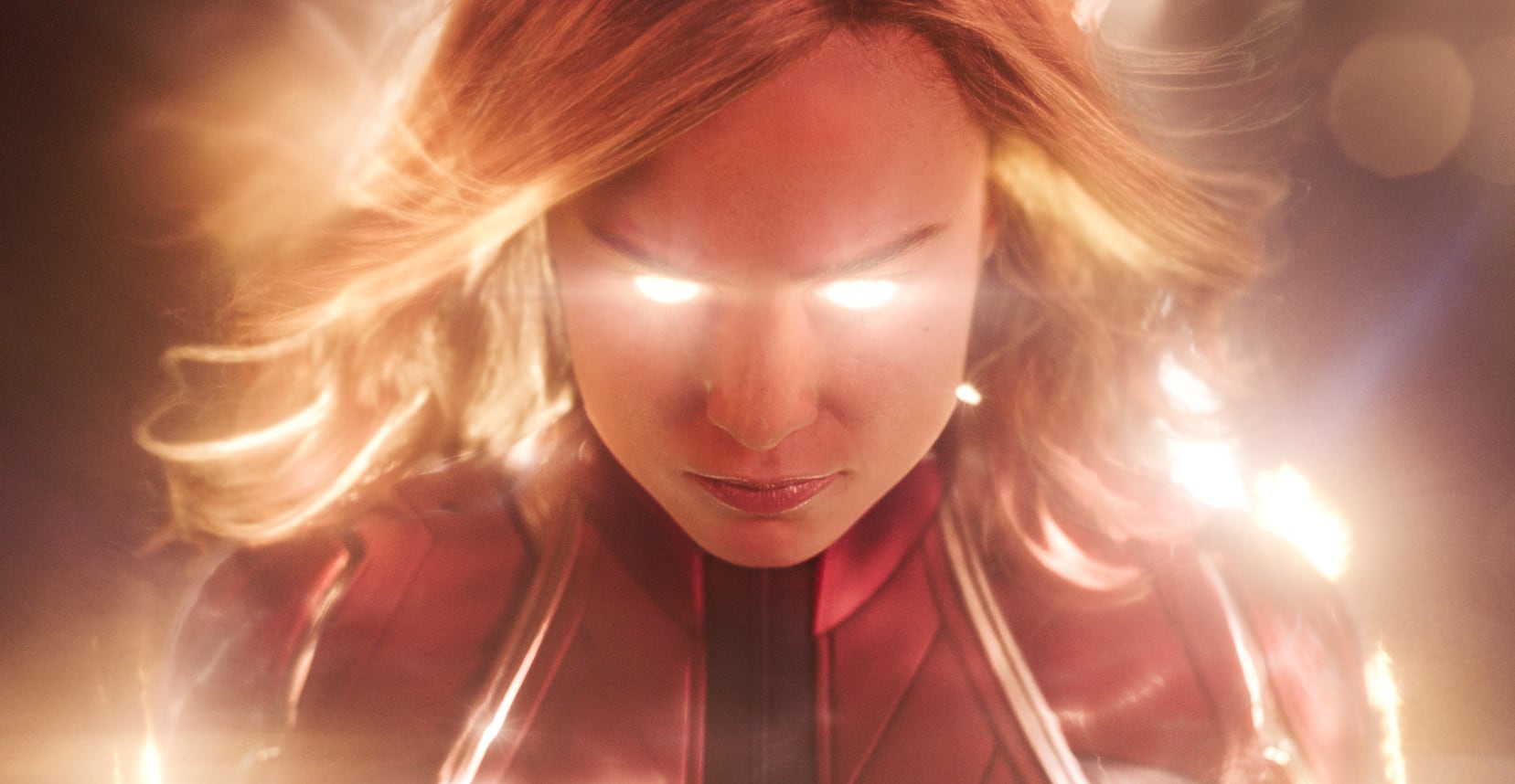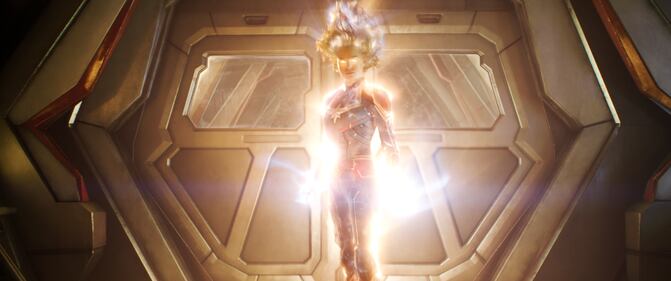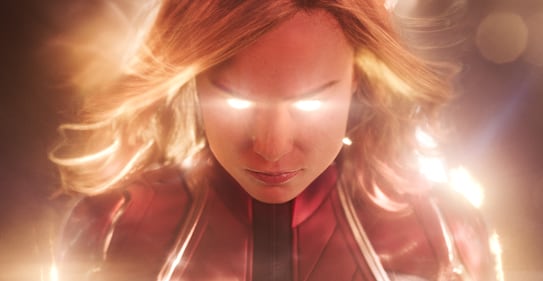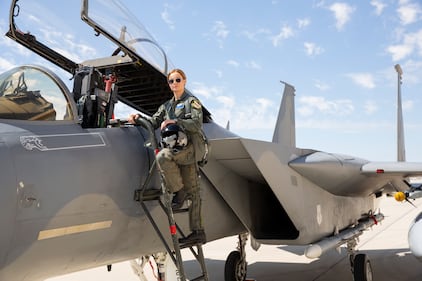“Captain Marvel,” the latest in Marvel’s series of blockbuster superhero films, is packed with hat tips and tributes to aviation history, culture and, in particular, a fallen Thunderbird whose death last year shook the Air Force.
The final version of the movie, which tells the story of superpowered F-15 pilot Carol Danvers, aka Captain Marvel, ends up giving the Air Force less actual screen time than the behind-the-scenes features and trailers suggest. Much of the film instead deals with the war between two alien races — the warrior Kree and the shape-shifting, lizard-like Skrulls — and what happens when that conflict spills onto an unsuspecting, mid-1990s Planet Earth, with Capt. Danvers caught in the middle.
But Danvers’ Air Force service sets the tone for the film and was the “grounding element” that drew directors Anna Boden and Ryan Fleck to her character, they said in a Feb. 22 interview with Air Force Times.
Comics writer Kelly Sue DeConnick, who came from an Air Force family and created this incarnation of Carol Danvers as Captain Marvel in 2012, “always described her as having a Chuck Yeager swagger,” Fleck said. “'The Right Stuff’ was a big influence on this movie as well.”
Boden, Fleck and the movie’s star, Oscar winner Brie Larson, famously traveled to Nellis Air Force Base in Nevada in January 2018, where they spent days talking to pilots, maintainers and other airmen, and even flew in fighter jets.
Brig. Gen. Jeannie Leavitt, the first female fighter pilot in the Air Force, who at the time was commander of Nellis’ 57th Wing, also met with Larson and the directors.
In a Feb. 11 interview, Leavitt said Larson was focused on getting her portrayal of a female fighter pilot right. Larson asked Leavitt about details as minute as how a fighter pilot would salute, interact with her crew chief, climb the ladder into the cockpit, carry her helmet bag and put on her flight gear.

Leavitt also told her about her flying experiences at events such as Red Flag and weapons school. The demanding pace of being a fighter pilot requires one to be very driven, she told Larson, and also described what it was like to be a woman, a wife and mother in the heavily male fighter pilot culture.
“I was very impressed with how interested she was in getting the character correct," Leavitt said of Larson. "With it being Hollywood, it doesn’t have to be accurate, and yet it was very important to her that she was accurate in her portrayal of a female fighter pilot. She spent a lot of time and asked a lot of questions to ensure she understood it. So I thought that spoke volumes about her as an actress.”
Boden said the stories Leavitt shared helped a great deal to shape the main character’s journey.
In a behind-the-scenes video released in January, Larson said her time at Nellis helped her understand where Danvers was coming from.
“The thing I found so unique about this character was that sense of humor, mixed with total capability in whatever challenge comes her way, which, I realized after going to the Air Force base, is really what Air Force pilots are like.” Larson said in the video, which also showed her flying in an F-16 at Nellis.
RELATED

That comes through in Larson’s performance as Danvers, who brims with the familiar fighter pilot confidence that comes from handling millions of dollars of technology at Mach speed. At the same time, Danvers’ struggle to understand where she fits in as part of this intergalactic war, and how to control her powers, makes for an engaging character arc.
The film doesn’t shy away from the challenges female pilots such as Danvers would have encountered about three decades ago — not only in the form of boorish comments, but also in the institutional restrictions on the missions they could fly.
All of that adds up to an engaging and sympathetic character, so when Danvers unleashes her Captain Marvel powers to their fullest extent, the film crackles with energy and delivers exactly the kind of rousing sequences for which the the best superhero flicks are known.
One airman whom the film crew met at Nellis was Thunderbirds pilot Maj. Stephen “Cajun” Del Bagno, the team’s skilled slot pilot who flew its No. 4 jet. Del Bagno and another Thunderbird later visited the movie’s set to consult.
But tragedy struck last April, a week after he consulted on the movie, when Del Bagno died in a crash while training.
The film crew grieved his loss, even though they had only known him for a few weeks. Boden said that Del Bagno gave her the call sign “Diplow,” and was an “energetic spirit [who] made us immediately feel at home and part of his world.”
Del Bagno “embraced us, wanted so much to teach us about the culture of the Air Force, loved that culture so much, taught us to appreciate it in a way that we wouldn’t have otherwise,” Boden said. “I just can’t explain how meaningful it was. He touched a lot of people on our set in the short time that he got to spend with us … and it was a very, very, very sad day when we found out and had to let everybody know.”
Larson also posted a tribute to Del Bagno on social media after he died, which she signed “Sparrow, forever,” her apparent call sign.
The film contains multiple tributes to Del Bagno. Not only is it dedicated to his memory, he even has a brief cameo. Del Bagno appears in a brief flashback scene playing Crud — a fast-paced, alcohol-soaked variant of billiards popular with fighter pilots — alongside Carol Danvers and her wingman, Maria Rambeau, at the squadron’s watering hole.
What’s more, Boden said the filmmakers snuck the word “Cajun” into the background of several scenes.
Fleck added that the filmmakers included a hidden Easter egg — a burning piano. The old fighter pilot tradition began, according to one version of the legend, in the UK’s Royal Air Force during World War II as a tribute to a fallen pilot. Supposedly, the first piano was burned when an RAF pilot, who was a gifted piano player and a beloved member of his squadron, was shot down and killed. Because he would never make music again, the story goes, that legendary pilot’s comrades burned his piano in his memory.
Several more aviation references can be found in “Captain Marvel” — the most obvious of which is the name of a scene-stealing cat, “Goose,” who hitches a ride with Danvers (and leaves Samuel L. Jackson’s character, SHIELD Agent Nick Fury, hilariously flabbergasted several times).
Even Danvers’ fighter pilot bar — Pancho’s Bar — is a clever reference to The Right Stuff lore. Boden confirmed that was named after Florence “Pancho” Barnes, a pioneering early aviator and stunt pilot who, among other accomplishments, founded the Women’s Air Reserve to ensure female pilots had a place in military aviation. She also, in 1930, broke the women’s speed record that had been held by Amelia Earhart.
Later, Barnes ran a ranch and dance hall at Edwards Air Force Base in California called the Happy Bottom Riding Club, which became enormously popular with pilots there. She gave free steak dinners there to Yeager and other pilots the first time they broke the sound barrier. Barnes and her club are memorably featured in the book and film “The Right Stuff.”
Image 0 of 8
The original version of “Captain Marvel” envisioned by the directors would have included longer stretches with Carol Danvers during her Air Force days, Boden said. However, as the film continued to develop, the directors pared away the story until most of it focused on the sci-fi, superhero elements.
But it is still unmistakably an Air Force film. Scenes of Danvers in a hangar and on a flightline were filmed at Edwards Air Force Base, Disney said. The F-15Cs in those scenes were flown in from the California Air National Guard’s 144th Fighter Wing, which is based in Fresno. And a flashback to Danvers’ days on the Air Force Academy obstacle course, filmed at a park in Culver City, California, looks close enough to pass for the woods of Jacks Valley in Colorado Springs, Colorado.
Leavitt said she hopes young people — especially young women — who go to see “Captain Marvel” come away with an interest in the Air Force and what it has to offer.
“She represents a role that so many young ladies could strive to do, in terms of becoming an officer, becoming an airman, [and] joining our Air Force,” Leavitt said. “So often, a lot of American society is not familiar with the Air Force. And so this, hopefully, will inspire people to learn more about the Air Force.”
As for supervillains across the galaxy? They’re about to learn that an airman is the last person you want to cross.
Stephen Losey is the air warfare reporter for Defense News. He previously covered leadership and personnel issues at Air Force Times, and the Pentagon, special operations and air warfare at Military.com. He has traveled to the Middle East to cover U.S. Air Force operations.












